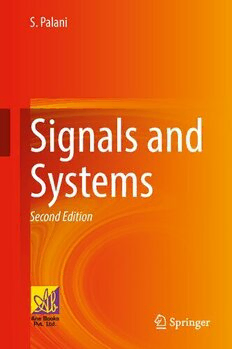
Signals and Systems PDF
Preview Signals and Systems
S. Palani Signals and Systems Second Edition Signals and Systems S. Palani Signals and Systems Second Edition S.Palani Professor(Retired) NationalInstituteofTechnology Tiruchirappalli,India ISBN978-3-030-75741-0 ISBN978-3-030-75742-7 (eBook) https://doi.org/10.1007/978-3-030-75742-7 JointlypublishedwithANEBooksPvt.Ltd. TheprinteditionisnotforsaleinSouthAsia(India,Pakistan,SriLanka,Bangladesh,NepalandBhutan) andAfrica.CustomersfromSouthAsiaandAfricacanpleaseordertheprintbookfrom:ANEBooks Pvt.Ltd. ISBNoftheCo-Publisher’sedition:978-9-383-65627-1 1stedition:©AneBooksPvt.Ltd.2017 2ndedition:©TheAuthor(s),underexclusivelicensetoSpringerNatureSwitzerlandAG2022 Thisworkissubjecttocopyright.AllrightsaresolelyandexclusivelylicensedbythePublisher,whether thewholeorpartofthematerialisconcerned,specificallytherightsofreprinting,reuseofillustrations, recitation,broadcasting,reproductiononmicrofilmsorinanyotherphysicalway,andtransmissionor informationstorageandretrieval,electronicadaptation,computersoftware,orbysimilarordissimilar methodologynowknownorhereafterdeveloped. Theuseofgeneraldescriptivenames,registerednames,trademarks,servicemarks,etc.inthispublication doesnotimply,evenintheabsenceofaspecificstatement,thatsuchnamesareexemptfromtherelevant protectivelawsandregulationsandthereforefreeforgeneraluse. Thepublishers,theauthors,andtheeditorsaresafetoassumethattheadviceandinformationinthisbook arebelievedtobetrueandaccurateatthedateofpublication.Neitherthepublishersnortheauthorsor theeditorsgiveawarranty,expressorimplied,withrespecttothematerialcontainedhereinorforany errorsoromissionsthatmayhavebeenmade.Thepublishersremainneutralwithregardtojurisdictional claimsinpublishedmapsandinstitutionalaffiliations. ThisSpringerimprintispublishedbytheregisteredcompanySpringerNatureSwitzerlandAG Theregisteredcompanyaddressis:Gewerbestrasse11,6330Cham,Switzerland Preface to Second Edition IhaveventuredtobringoutthesecondeditionofthebookSignalsandSystemsinits newformduetothesuccessandwidepatronageextendedtothepreviouseditionand reprintsbythemembersoftheteachingfacultyandstudentcommunity.Thepresent editionasinthepreviouseditioncoverstheundergraduatesyllabusinSignalsand Systems fortheB.E.degreecourses.Athoroughrevisionofallthechaptersinthe previouseditionhasbeenundertaken.Fewerrorsnoticedinthepreviouseditionhave beenremovedandappropriatecorrectionshavebeenmade.Signalrepresentationis a vital topic to understand the importance of the theoretical concepts in Signals andSystems.AlargenumberofnumericalproblemshavebeenincludedinChap.1 which describes signal representation (both continuous and discrete time signals). Similarly,theclassificationofsystemsiswellexplainedinChap.2withgraphical illustrationwhereverpossible.Morenumberofnumericalproblemshavebeenadded inChap.4whichdescribesFourierSeriesAnalysis.Further,thepropertiesofFSare well explained and applied in solving many FS problems by cutting short lengthy procedures.Similarly,inChap.6,explanationisprovidedfortheFourierTransform methodofAnalysisandforthepropertiesofFTwhicharefrequentlyusedtosolve numericalproblemsinaneasierway.However,inFSandFT,conventionalmethods ofsolvingthenumericalproblemsarealsoretained.InChap.8,numericalproblems using LT properties have been solved. I hope that the readers of this book would appreciate the above attempts. Since every theoretical concept is explained by a varietyofnumericalexampleswhicharepresentedinagradedmanner,thebookis voluminous.ItakethisopportunitytothankAneBooksPvt.Ltdandthepublisher fortakingupthisdifficultjob. Pudukkottai,India S.Palani v Preface to First Edition ThebookSIGNALSANDSYSTEMSpresentsacomprehensivetreatmentofsignals and linear systems for the undergraduate level study. It is a rich subject with diverse applications such as signal processing, control systems and communica- tion systems. It provides an integrated treatment of continuous-time and discrete- timeformsofsignalsandsystems.Thesetwoformsaretreatedsidebyside.Even thoughcontinuous-timeanddiscrete-timetheoryhavemanymathematicalproperties commonbetweenthem,thephysicalprocessesthataremodelledbycontinuous-time systemsareverymuchdifferentfromthediscrete-timesystemscounterpart. IhavewrittenthisbookwiththematerialIhavecollectedduringmylongexperi- enceofteachingsignalsandsystemstotheundergraduatelevelstudentsinnational levelreputedinstitutions.Thebookinthepresentformiswrittentomeettherequire- mentsofundergraduatesyllabusofIndianUniversitiesingeneralandAnnaUniver- sityinparticularforB.E./B.Tech.degreecourses.Theorganizationofthechapters isasfollows. Chapter1dealswiththerepresentationofsignalsandsystems.Itmotivatesthe reader as to what signals and systems are and how they are related to other areas such as communication systems, control systems and digital signal processing. In thischapter,variousterminologiesrelatedtosignalsandsystemsaredefined.Further, mathematicaldescription,representationandclassificationsofsignalsandsystems areexplained. Chapter2presentsadetaileddescriptionsofsystemclassifications.Underbroader category,systemsareclassifiedascontinuous-timeanddiscrete-timesystems.Each ofthemisfurtherclassifiedaslinearandnon-linear,timeinvariantandtimevarying, static and dynamic, causal and non-causal, stable and unstable and invertible and non-invertible.Systemsareidentifiedaccordingly. A comprehensive treatment of time domain analysis of continuous-time and discrete-timesystemsaregiveninChapter3.Itdevelopsconvolutionfromtherepre- sentationofaninputsignalsasasuperpositionofimpulses.Tofindtheconvolution oftwotimesignals,bothanalyticalaswellasgraphicalmethodsareexplained. Chapter 4 deals with the Fourier representation of continuous-time signals. Continuous time periodic signals are represented by trigonometric Fourier series, polarFourierseriesandexponentialFourierseries. vii viii PrefacetoFirstEdition In Chapter 5, discrete-time signals is represented by exponential Fourier series andtheirpropertiesarederived.TheFourierspectraofdiscrete-timesignalisalso determinedinthischapter. ItisnotpossibletofindFourierseriesrepresentationofnon-periodicsignals.In Chapter6,Fouriertransformisintroducedwhichcanrepresentperiodicaswellas non-periodicsignals.InthischaptertheFouriertransformforcontinuous-timesignal isexplained. InChapter7,therepresentationofdiscrete-timesignalusingdiscretetimeFourier transformisexplained.Further,discreteFouriertransformandFastFourierTrans- form algorithm are also explained here. The Laplace transform is a very powerful toolintheanalysisofcontinuoustimesignalsandsystems. InChapter8,theLaplacetransformmethodisexplainedanditspropertiesderived. The use of Laplace transform to solve differential. equation is described. Finally differentformsofstructurerealizationofcontinuous-timesystemsarediscussed. Chapter9isdevotedtothez-transformanditsapplicationtodiscretetimesignals and systems. The properties of z-transform and techniques for inversion are intro- duced in this chapter. The use of z-transform for solving difference equation is explained. Different forms of structure realization of discrete-time system is also explainedinthischapter. In Chapter 10, the sampling theorem is explained. The necessary condition to avoidaliasingisalsoexplainedhere. Thenotablefeaturesofthisbookincludesthefollowing: 1. Thesyllabuscontentofsignalsandsystemsforundergraduatelevelofmostof the Indian Universities in general and Anna University in particular has been covered. 2. Theorganizationofthechapteraresequentialinnature. 3. Largenumberofnumericalexampleshavebeenworkedout. 4. Chapterobjectivesandsummaryaregivenineachchapter. 5. Forthestudentstopractice,shortandlongquestionswithanswersaregivenat theendofeachchapter. ItakethisopportunitytothankShri.Sunil,ManagingDirectorAneBooksIndia,for coming forward to publish the book. I would like to express my sincere thanks to Shri.R.Krishnamoorthi,salesmanagerAneBooksIndiawhotooktheinitiativesto publishthebookinashortspanoftime.Iwouldliketoexpressmysincerethanksto Mr.V.Ashokwhohasdoneawonderfuljobtokeythevoluminousbooklikethisin averyshorttimeandbeautifullytoo.Mysincerethanksarealsoduetomycolleague PrefacetoFirstEdition ix Mr.N.Sathurappanwhogavesomeusefulsuggestions.Iwouldalsoliketothankmy wifeDr.S.Manimegalai,M.B.B.S.,M.D.,whowasthesourceofinspirationwhile preparingthisbook. S.Palani Contents 1 RepresentationofSignals ..................................... 1 1.1 Introduction ............................................ 1 1.2 TerminologiesRelatedtoSignalsandSystems ............... 2 1.2.1 Signal ......................................... 2 1.2.2 System ........................................ 2 1.3 ContinuousandDiscreteTimeSignals ..................... 3 1.4 BasicContinuousTimeSignals ............................ 6 1.4.1 UnitImpulseFunction ........................... 6 1.4.2 UnitStepFunction .............................. 7 1.4.3 UnitRampFunction ............................ 8 1.4.4 UnitParabolicFunction ......................... 10 1.4.5 UnitRectangularPulse(orGate)Function ......... 10 1.4.6 UnitAreaTriangularFunction .................... 11 1.4.7 UnitSignumFunction ........................... 12 1.4.8 UnitSincFunction .............................. 12 1.4.9 SinusoidalSignal ............................... 12 1.4.10 RealExponentialSignal ......................... 13 1.4.11 ComplexExponentialSignal ..................... 14 1.5 BasicDiscreteTimeSignals .............................. 15 1.5.1 TheUnitImpulseSequence ...................... 15 1.5.2 TheBasicUnitStepSequence .................... 15 1.5.3 TheBasicUnitRampSequence ................... 16 1.5.4 UnitRectangularSequence ....................... 16 1.5.5 SinusoidalSequence ............................ 17 1.5.6 DiscreteTimeRealExponentialSequence .......... 19 1.6 BasicOperationsonContinuousTimeSignals ............... 19 1.6.1 AdditionofCTSignals .......................... 20 1.6.2 MultiplicationsofCTSignals .................... 21 1.6.3 AmplitudeScalingofCTSignals ................. 21 1.6.4 TimeScalingofCTSignals ...................... 22 1.6.5 TimeShiftingofCTSignals ...................... 22 1.6.6 SignalReflectionorFolding ...................... 24 xi xii Contents 1.6.7 InvertedCTSignal .............................. 24 1.6.8 MultipleTransformation ......................... 26 1.7 BasicOperationsonDiscreteTimeSignals .................. 77 1.7.1 AdditionofDiscreteTimeSequence ............... 77 1.7.2 MultiplicationofDTSignals ..................... 77 1.7.3 AmplitudeScalingofDTSignal .................. 79 1.7.4 TimeScalingofDTSignal ....................... 79 1.7.5 TimeShiftingofDTSignal ...................... 80 1.7.6 MultipleTransformation ......................... 81 1.8 ClassificationofSignals .................................. 103 1.8.1 Deterministic and Non-deterministic ContinuousSignals ............................. 103 1.8.2 PeriodicandNon-periodicContinuousSignals ...... 103 1.8.3 FundamentalPeriodofTwoPeriodicSignals ....... 105 1.8.4 OddandEvenFunctionsofContinuousTime Signals ........................................ 121 1.8.5 EnergyandPowerofContinuousTimeSignals ..... 143 1.9 ClassificationofDiscreteTimeSignals ..................... 162 1.9.1 PeriodicandNon-PeriodicDTSignals ............. 162 1.9.2 OddandEvenDTSignals ........................ 170 1.9.3 EnergyandPowerofDTSignals .................. 178 2 ContinuousandDiscreteTimeSystems ......................... 197 2.1 Introduction ............................................ 197 2.2 LinearTimeInvariantContinuous(LTIC)TimeSystem ....... 198 2.3 LinearTimeInvariantDiscrete(LTID)TimeSystem ......... 199 2.4 Properties(Classification)ofContinuousTimeSystem ....... 199 2.4.1 LinearandNon-linearSystems ................... 200 2.4.2 TimeInvariantandTimeVaryingSystems .......... 212 2.4.3 StaticandDynamicSystems(Memoryless andSystemwithMemory) ....................... 216 2.4.4 CausalandNon-causalSystems .................. 220 2.4.5 StableandUnstableSystems ..................... 225 2.4.6 InvertibilityandInverseSystem ................... 230 2.5 DiscreteTimeSystem .................................... 241 2.6 PropertiesofDiscreteTimeSystem ........................ 241 2.6.1 LinearandNon-linearSystems ................... 242 2.6.2 TimeInvariantandTimeVaryingDTSystems ...... 246 2.6.3 CausalandNon-causalDTSystems ............... 248 2.6.4 StableandUnstableSystems ..................... 251 2.6.5 StaticandDynamicSystems ..................... 254 2.6.6 InvertibleandInverseDiscreteTimeSystems ....... 256
